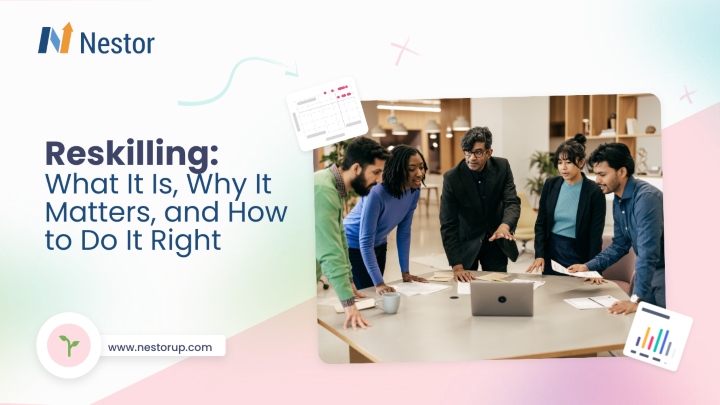
Contents
Leadership development. The phrase itself feels corporate, doesn’t it? Like something you’d hear in a beige conference room with bad coffee and even worse PowerPoint slides.
But behind the jargon, it’s a very real need. Organizations that invest in leadership development aren’t just filling training quotas. They’re building the people who will guide their future. Whether you’re a team lead, a manager, or the CEO, your ability to lead (or help others lead) shapes everything from performance to workplace culture.
Good leadership development sharpens decision-making. It boosts morale, it fixes problems before they escalate, it even saves money. Yet, most companies either ignore it or do it badly. Why? Because it’s often treated as an afterthought or a glorified checklist.
You’ve probably seen it yourself. Generic seminars, outdated advice, people nodding along but forgetting everything the next day. Sound familiar?
So here’s the real question: How do you make leadership development actually useful and not just another “initiative”? Let’s find out.
What is Leadership Development?
Leadership development is the process of improving someone’s ability to guide, influence, and support others effectively. It’s about building the core skills, mindset, and behaviors that make people better leaders, whether they’re managing a team of three or running an entire company.
It’s not a luxury for big corporations or reserved for executives in glass-walled offices. It’s a critical investment for organizations of every size because leadership shows up at every level: team leads, project managers, middle managers, and yes, the C-suite too.
Here’s what leadership development really means:
- Self-awareness: Knowing your strengths, weaknesses, and how your actions impact others.
- Communication: Being able to clearly articulate goals, provide feedback, and foster open dialogue.
- Decision-making: Analyzing situations, weighing options, and making choices that align with business goals.
- Emotional intelligence: Managing your emotions and understanding others to build strong working relationships.
- Strategic thinking: Looking beyond daily tasks to plan for the future and align team efforts with organizational objectives.
- People development: Coaching and mentoring others to help them grow and succeed.
Why does this matter?
Because companies that prioritize leadership development outperform those that don’t. Period.
Organizations with highly rated leadership development programs were 8.8 times more likely to have high leadership quality and bench strength compared to those organizations with low-rated programs. That’s not a motivational quote. That’s hard data. Leadership development is directly tied to business performance.
If you build leadership skills intentionally – not through outdated seminars or check-the-box training – you create a workforce that can:
- Handle challenges without constant oversight
- Collaborate better across teams
- Innovate faster
- Retain top talent because people want to work for good leaders
In other words, leadership development is about future-proofing your organization. It’s building the people who will solve tomorrow’s problems.
Why Leadership Development Should Be a Priority
Companies that don’t invest in leadership development usually feel the pain later. Low morale. High turnover. Poor performance. Teams that fall apart under stress.
On the other hand, organizations that take it seriously see huge benefits:
1. Better Leaders, Better Teams
A team’s performance reflects its leader. Great leaders know how to motivate, coach, and get the best out of their people. Poor leaders create confusion, frustration, and eventually resignations.
Consider this: Gallup’s 2023 research revealed that 70% of team engagement is directly tied to the quality of the manager or team leader. That’s not optional. If your leaders aren’t equipped, your teams suffer.
Good leadership turns average teams into high-performing ones. It reduces friction, clarifies priorities, and fosters a positive work environment where people can actually thrive.
2. Succession Planning Without Panic
Ever seen a company scramble when a key leader quits? That’s what happens when there’s no leadership development pipeline.
Leadership development builds “ready now” talent; people prepared to step into bigger roles when the time comes. It’s proactive, not reactive.
A study by Deloitte found that only 14% of companies believe they have a strong succession plan in place. Yet leadership turnover is inevitable. Whether it’s retirement, resignations, or unexpected exits, you’ll need leaders to fill the gaps.
If you’re not developing leaders today, you’re risking a leadership vacuum tomorrow.
3. Higher Employee Engagement and Retention
People leave bad bosses, not companies. You’ve heard this before because it’s true.
According to a McKinsey & Company survey, 57% of employees who quit cited poor leadership and lack of growth opportunities as key reasons for leaving. On the flip side, companies that invest in leadership development see higher engagement, loyalty, and retention rates.
It’s a simple equation:
Good leaders = Happy employees
Happy employees = Lower turnover
Lower turnover = Lower hiring costs and better team stability
4. Direct Impact on Business Performance
Leadership isn’t some abstract concept floating above day-to-day work. It hits your bottom line.
Companies with effective leadership development programs report:
- 24% higher profit margins
- 19% higher innovation levels
- 22% improvement in customer satisfaction scores
When leaders are trained to manage change, resolve conflicts, and inspire performance, it reflects everywhere: in sales, in customer interactions, in project outcomes.
5. Faster, Smarter Decision-Making
Without capable leaders, decisions get bottlenecked. Teams stall waiting for direction. Mistakes get repeated. Momentum is lost.
Developed leaders know how to analyze situations, consult the right people, and make informed decisions quickly. They don’t need constant escalation. This agility gives companies a competitive edge.
6. Shaping a Culture of Accountability and Growth
Leadership behavior shapes culture more than policies, perks, or slogans ever will. If you want a culture where people take ownership, collaborate, and grow, you need leaders who model that behavior.
Leadership development ensures your leaders aren’t just enforcing rules, but embodying the values you want to see in your organization.
Quick Recap (Because You’re Busy)
Leadership development:
- Boosts team engagement
- Prevents succession crises (Deloitte says only 14% are ready)
- Reduces turnover (57% quit over bad leadership, McKinsey reports)
- Improves profits, innovation, and customer satisfaction
- Speeds up decision-making
- Builds a stronger, growth-oriented company culture
Still think it’s optional? Didn’t think so.
The Core Elements of an Effective Leadership Development Program
Throwing people into a classroom for a day isn’t leadership development. Neither is sending out an article and calling it “training.”
Here’s what actually works:
1. Self-Awareness Comes First
Before you can lead others, you need to understand yourself. Strengths, blind spots, stress triggers. It all starts here. Tools like 360-degree feedback, personality assessments, and honest conversations help.
2. Focus on Practical Skills
Forget abstract theories. Leaders need to get better at:
- Giving constructive feedback
- Managing conflict
- Leading meetings that don’t suck
- Coaching and developing team members
- Decision-making under pressure
Real-world scenarios. Role-playing. Shadowing experienced leaders. This is where skills are built.
3. Mentorship and Coaching
Formal training is good, but learning from people who’ve been there is better. A good mentorship program accelerates growth. External coaches can also provide unbiased guidance and support.
4. On-the-Job Learning
Leaders grow fastest when facing real challenges. Special projects, cross-functional teams, temporary leadership roles. These stretch assignments build competence and confidence.
5. Continuous Feedback Loops
One-time training isn’t enough. Leaders need ongoing feedback from peers, mentors, and direct reports. Regular check-ins help them stay on track.
How to Build a Leadership Development Program
1. Start with Clear Business Goals, Not Just “Leadership” Vibes
Before you even think about workshops or coaches, get brutally clear on this:
What business problems are you trying to solve with leadership development?
For example:
- Are teams struggling with collaboration?
- Is decision-making too slow?
- Are managers failing to engage and retain their people?
- Do you lack internal candidates for leadership roles?
Define the real pain points. Your leadership development program should be designed to solve these, not just “develop leaders” in theory.
Pro Tip: Involve senior leaders and HR early to align development goals with company strategy.
2. Identify Who Needs Development And What Kind
Not everyone needs the same leadership skills. Avoid the “one-size-fits-all” trap.
Break it down:
- Emerging leaders → Need basics: giving feedback, managing time, leading small teams.
- Mid-level managers → Need advanced skills: strategic thinking, cross-functional leadership, conflict resolution.
- Senior leaders → Need to focus on vision, influencing culture, driving large-scale change.
Create learning paths tailored to each level. Generic training = generic results.
Pro Tip: Use skills assessments, manager feedback, and even 360° reviews to identify gaps.
3. Make It Practical (Because Theory Won’t Save You in a Crisis)
People don’t learn leadership from slideshows. They learn by doing.
Build your program around real-world application:
- Simulations of tough leadership situations
- Role-playing feedback and coaching conversations
- Case studies from within your own company
- Project-based learning with cross-functional teams
- Job rotations or “acting” leadership roles
Make the learning experience as close to reality as possible.
Pro Tip: Focus on “microlearning”: short, focused sessions that fit into busy schedules. No one wants an 8-hour leadership lecture.
4. Incorporate Mentorship and Coaching
Formal training teaches concepts. Mentorship and coaching develop judgment.
- Internal mentors pass on organizational wisdom and culture.
- External coaches provide unbiased feedback and personal growth strategies.
Both are essential.
Pro Tip: Match mentors and mentees carefully. Compatibility matters more than hierarchy.
5. Create a Feedback-Driven Learning Loop
Learning without feedback is like shouting into the void.
Build regular feedback into your program:
- After-action reviews post-training
- Peer feedback on leadership behaviors
- Manager check-ins to track progress
- Self-reflection exercises
Use this data to adapt and improve the program continuously.
Pro Tip: Don’t wait until the “end” of the program to measure impact. Check-in early and often.
6. Ensure Leadership Development Is Continuous, Not One-and-Done
Leadership is not a box you check. It’s an ongoing process.
Design your program as a continuous journey, not a single event:
- Monthly learning labs
- Leadership discussion forums
- On-demand learning resources (videos, articles, podcasts)
- Yearly leadership retreats (focused on evolving skills)
Keep the momentum going.
Pro Tip: Build leadership development into daily work. Encourage “leaders as teachers” by having experienced leaders run learning sessions.
7. Measure What Matters
How do you know your leadership development program is working? Hint: It’s not just “attendance numbers.”
Track:
- Promotion rates of program participants
- Team engagement and retention metrics
- Business KPIs linked to leadership behaviors (e.g., project delivery rates, customer satisfaction)
- Pre- and post-program assessments of leadership competencies
If you can’t tie the program to business outcomes, you’re doing it wrong.
Pro Tip: Create a dashboard for leadership development metrics. Visibility drives accountability.
8. Get Buy-In from the Top
If senior leadership doesn’t walk the talk, your program won’t stick. Leaders must model the behaviors being taught. They should actively participate, not just endorse from the sidelines.
When top leaders engage in development openly, it signals that leadership growth is valued, not optional.
Pro Tip: Have senior leaders share their own leadership development stories, including failures. Authenticity resonates more than corporate slogans.
Common Mistakes to Avoid (That Most Companies Still Make)
Leadership development often fails because of avoidable blunders. Watch out for these:
Leadership development sounds simple on paper. Teach people to lead. Support their growth. Reap the rewards.
But in reality, many companies stumble over the same avoidable mistakes. Not because they don’t care, but because they fall into outdated habits or rush the process.
Here are the most common pitfalls and how to steer clear of them:
1. Treating Leadership Development as a One-Time Event
A single workshop or seminar won’t create effective leaders. Leadership is learned over time, through continuous practice and feedback.
Mistake: Companies often run a “leadership bootcamp” once a year, tick a box, and call it done.
Better Approach: Make leadership development an ongoing process. Blend formal training with real-world projects, mentoring, and regular feedback loops. Learning should be part of the work, not an occasional sideline.
2. Focusing Only on Technical Skills
Knowing how to read a spreadsheet or manage workflows is important. But leadership goes far beyond task management.
Mistake: Overemphasizing hard skills while neglecting soft skills like emotional intelligence, conflict resolution, and coaching.
Better Approach: Balance technical proficiency with human-centered skills. Great leaders connect with people, manage dynamics, and inspire trust. These “soft” skills often drive the biggest results.
3. Ignoring Middle Managers
Middle managers are the backbone of any organization. They’re the link between strategy and execution. Yet, they often get overlooked in leadership development efforts.
Mistake: Focusing resources on top executives while middle managers are left to “figure it out” on their own.
Better Approach: Invest in your middle managers. Equip them with the tools to manage up, down, and across the organization. Their influence on team performance and morale is massive.
4. Lack of Practical Application
Leaders don’t learn much from passive lectures or endless slide decks. What sticks is hands-on experience.
Mistake: Too much theory, not enough practice. Attendees leave sessions unsure how to apply what they learned.
Better Approach: Incorporate simulations, case studies, role-playing, and real-life projects into your programs. Learning by doing builds competence and confidence.
5. Measuring the Wrong Things or Nothing at All
You can’t improve what you don’t measure. Yet, many companies rely on vague feedback like “the workshop was well-received” without tracking real outcomes.
Mistake: Measuring attendance instead of business impact. No link between development efforts and actual performance metrics.
Better Approach: Track relevant KPIs: employee engagement, promotion rates, team productivity, retention, and business outcomes. Use 360-degree feedback to assess leadership behaviors over time.
6. No Clear Alignment with Business Goals
Leadership development can’t exist in a vacuum. If it’s not connected to business strategy, it risks becoming irrelevant.
Mistake: Running programs without a clear link to company objectives or challenges.
Better Approach: Align leadership development initiatives with organizational priorities. Whether it’s driving innovation, improving collaboration, or preparing for expansion, leadership training should directly support those goals.
How to Measure Leadership Development Success
“You can’t manage what you don’t measure.” It’s a cliché because it’s true.
Leadership development is no exception. If you’re investing time and resources into growing your leaders, you need a way to prove it’s working, not just “feel” like it’s working.
But measuring leadership success isn’t as simple as tracking attendance at workshops. Leadership is about behavior, influence, and results. Measuring those things requires a combination of smart metrics, consistent feedback, and a clear connection to business goals.
Here’s how to do it:
1. Track Internal Promotions
Leadership development should create a clear talent pipeline. If your program is effective, you’ll start seeing people from it stepping into leadership roles.
It’s not about “filling seats.” It’s about filling them with people who are ready.
If you notice that leadership positions are often filled by external hires, that’s a sign your internal development isn’t producing leaders who are prepared to take on more responsibility.
Tracking promotions helps answer critical questions:
- Are participants of your leadership program advancing?
- Are they succeeding in their new roles?
- Is there a noticeable difference in leadership quality after promotions?
If promotions are stagnant or failing, your program might need to be reworked.
2. Employee Retention and Engagement Scores
Leadership directly affects team morale. Good leaders create environments where people want to stay. Bad leaders? They drive your best people away.
You should look at retention and engagement data, especially in teams led by program participants. Are people staying longer? Are they more engaged?
Engagement surveys, pulse checks, and even informal feedback sessions can reveal whether leadership behaviors are improving the employee experience.
If turnover is high, or engagement is low in specific teams, dig into the leadership dynamics. Development efforts should show visible improvements here.
3. Team Performance Metrics
A well-developed leader lifts team performance. This goes beyond individual brilliance. It’s about how the team as a whole performs.
Key things to look for:
- Are teams hitting their targets more consistently?
- Is there better collaboration across functions?
- Are projects being delivered on time and within scope?
- Is there less drama and fewer escalations?
You should see measurable improvements in how teams operate under trained leaders. If not, revisit whether your development program is equipping them with the right skills.
Performance speaks louder than certificates.
4. 360-Degree Feedback Results
Leadership is multi-dimensional. It’s not enough to be liked by your boss. Peer relationships, team dynamics, and upward influence all matter.
360-degree feedback gathers insights from everyone around a leader: their manager, peers, direct reports, and sometimes even clients.
These feedback loops give you a rounded view of:
- Communication effectiveness
- Emotional intelligence
- Conflict management
- Ability to develop others
- Leadership presence and credibility
You’ll want to compare feedback over time. If a participant’s scores are improving, you know the development efforts are working.
It’s qualitative, yes, but it’s also incredibly telling.
5. Business Outcomes
At the end of the day, leadership development isn’t an isolated HR project. It should contribute to business success.
This doesn’t mean expecting an immediate spike in revenue after a training session. But over time, strong leadership should lead to better business performance.
Areas where leadership development often shows up:
- Increased customer satisfaction (happy teams = better service)
- More efficient processes (leaders who can identify and solve problems)
- Higher innovation and agility
- Improved project success rates
You want to establish a connection between leadership initiatives and these business outcomes. This ties your efforts to tangible results, making it easier to justify continued investment.
Leadership Development for Different Levels: A Practical Approach
Not all leaders are the same. The challenges a first-time manager faces are worlds apart from those of a senior executive. Your leadership development strategy needs to reflect these differences. Trying to teach high-level strategy to someone still learning how to run a meeting is a waste of time. Likewise, giving surface-level “how to manage tasks” workshops to senior leaders insults their experience.
Here’s how to approach leadership development by level, with clarity and purpose.
Emerging Leaders (First-time Managers)
These are your team leads, new supervisors, or individual contributors stepping into their first management role. For many, this is their first time being responsible for other people’s performance; a huge mindset shift.
What they need:
- Foundational Management Skills
Before anything else, they need to learn how to organize, prioritize, and guide a team. This includes basics like task delegation, managing workloads, and handling daily team operations. - Giving Feedback & Managing Performance
Giving honest, constructive feedback is often the most uncomfortable part for new managers. They need practical tools and scripts to have these conversations effectively, without feeling like “the bad guy.” - Running Effective Meetings
Meetings are where leadership plays out in real-time. Teach them how to set agendas, keep discussions on track, and make meetings productive, not painful. - Setting Clear Expectations
Ambiguity kills productivity. First-time managers need to know how to define clear roles, responsibilities, and performance standards for their team. - Peer Coaching & Mentoring from Senior Leaders
Learning from experienced managers can accelerate growth. Pair emerging leaders with mentors who can offer real-world advice, not just textbook theory.
The focus here is to build confidence in leading others and shifting from “doer” to “leader.” Small, hands-on learning bites work best.
Mid-Level Managers
Mid-level managers sit in the “pressure sandwich.” They manage teams but also answer to senior leadership. They’re the bridge between strategy and execution.
At this level, leadership challenges become more complex.
What they need:
- Strategic Thinking & Business Acumen
They must start thinking beyond their own team. Teach them to understand the bigger business picture: budgets, KPIs, interdepartmental dynamics, and how their decisions impact the company. - Advanced Delegation & Empowerment
Mid-level leaders must let go of micromanagement and focus on empowering their direct reports to take ownership. Delegating effectively becomes essential to avoid burnout and build team capacity. - Cross-Functional Collaboration
At this level, success depends on working with other teams. Developing skills in negotiation, influencing without authority, and navigating internal politics is key. - Conflict Resolution & Difficult Conversations
Managing interpersonal conflicts, addressing underperformance, and handling sensitive issues with maturity are non-negotiable leadership skills here. - Stretch Assignments & Special Projects
Give mid-level managers opportunities to lead cross-functional projects or initiatives outside their usual scope. This helps them develop broader leadership experience and prepares them for more senior roles.
The focus here is on expanding their leadership scope, from managing tasks and people to influencing systems and driving results across the organization.
Senior Leaders
Now we’re talking about department heads, directors, VPs, and the executive suite. At this level, leadership is less about direct management and more about vision, influence, and large-scale impact.
What they need:
- Vision-Setting & Strategic Leadership
Senior leaders must craft and communicate a clear vision that aligns with organizational goals. They should be skilled at inspiring teams and fostering alignment across departments. - Leading Organizational Change
Change is constant. Senior leaders need to master change management, guiding teams through transitions, overcoming resistance, and maintaining morale during uncertain times. - Influencing at Scale
Their role requires influencing peers, stakeholders, board members, and even external partners. It’s less about authority and more about persuasive communication and relationship-building. - Executive Coaching for Personal Growth
Senior leaders benefit from personalized coaching focused on refining their leadership style, addressing blind spots, and enhancing executive presence. - Peer Learning & Leadership Forums
Facilitate learning circles where senior leaders can exchange ideas, tackle challenges collaboratively, and learn from each other’s experiences. This peer-to-peer learning is often more impactful than formal training at this stage.
The focus here is on leading through others, shaping company culture, and driving long-term business outcomes. It’s about legacy, influence, and strategic impact.
Final Thoughts on Leadership Development
Leadership development it’s about building the people who will drive your business forward.
If you don’t invest in developing leaders at every level, you’re leaving your company’s future to chance. Weak leadership creates disengaged teams, high turnover, and missed opportunities. Strong leadership builds high-performing teams, keeps your best people engaged, and ensures your business stays competitive.
The companies that prioritize leadership development build resilient teams. They adapt faster, retain talent and outperform the competition. If you’re serious about long-term success, leadership development needs to stop being an afterthought and start being a priority.
So, are you investing in leadership development? Or are you still hoping “natural leaders” will magically appear?
Your choice. Your future.










